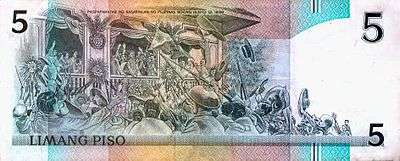Philippine five peso note
| (Philippines) | |
|---|---|
| Value | 5 pesos |
| Width | 160 mm |
| Height | 66 mm |
| Security features | Security fibers, Watermark, See-through mark, Concealed value, Security thread |
| Paper type |
90% cotton 10% linen |
| Years of printing | 1896-1996 |
| Obverse | |
 | |
| Design | Emilio Aguinaldo, Philippine independence marker |
| Designer | Romeo Mananquil |
| Design date | 1985 |
| Reverse | |
 | |
| Design | Declaration of Philippine independence |
| Designer | Romeo Mananquil |
| Design date | 1985 |
The Philippine five-peso note (₱5) is a denomination of Philippine currency. Philippine president Emilio Aguinaldo is featured on the front side of the bill, while the Declaration of the Philippine Independence is featured on the reverse side. This banknote was circulated until the Bangko Sentral ng Pilipinas stopped printing this denomination in 1995 and was replaced by coins.
Pre-independence history
- 1903: Philippine Islands issued silver certificates. Features a portrait of William McKinley.
- 1908: Banco Español Filipino issued notes.
- 1920: BPI issued notes.
- 1936: PNB issued notes.
- 1937: Philippine Commonwealth issued treasury certificate. Features the portraits of William McKinley and George Dewey on both sides of the obverse. This series were later overprinted with the word "VICTORY" on the reverse after the liberation of the Philippines under Japanese rule in 1944.
- 1942: Japanese government issued series. Features a farmer in a forest on the right of the obverse, with the number "5" on the center. Another version, this time featuring the Rizal Monument on the right of the obverse, was released in 1944. The banknotes ceased to be legal tender after the liberation.
Post-independence history
Aguinaldo first appeared on the five peso bill upon the release of the New Design series notes in 1985.
- 1951: English series, Features the portraits of Marcelo H. Del Pilar and Graciano Lopez-Jaena, two important figures of the Propaganda movement before the Philippine revolution, on the obverse. The reverse features the official newspaper of the propaganda movement, the La Solidaridad.
- 1969: Pilipino series, Andres Bonifacio replaced the portraits of Del Pilar and Lopez-Jaena. The note is now predominantly green in color. On the reverse, it now features the scenario of how to be a member of Katipunan through signing a contract by their own blood. The design of the obverse was later revised, the font for the text Republika ng Pilipinas and Limang Piso was changed, the color of the portrait of Bonifacio was changed from brown to green and geometric lines were added on the sides and the watermark area of the bill. This design was later used when the Bagong Lipunan series was released in 1973.
- 1972: Ang Bagong Lipunan series, The "Ang Bagong Lipunan" text was added and was overprinted on the watermark area.
- 1985: New design series, The bill was completely redesigned and Emilio Aguinaldo replaced Bonifacio in this series. The NHCP historical marker in the Barasoain Church (indicating the foundation of the First Philippine Republic, which Aguinaldo became its president) along with a cannon can be seen on the right side of the obverse. On the reverse, a scene from the Declaration of the Philippine Independence is featured. This was previously featured on the reverse of the Ang Bagong Lipunan series two peso banknote.
- 1993: After the creation of the "Bangko Sentral ng Pilipinas", its new logo was incorporated on all the New Design series bills.
- 1996: The printing of this banknote was stopped after the Bangko Sentral ng Pilipinas released the new ₱5 coin denomination that coincided the launching of the Improved Flora and Fauna series coins. Existing banknotes remained legal tender and were demonetized in 2016 after the release of the New Generation series bills in 2010.
.jpg) English series ₱5 bill.
English series ₱5 bill. Pilipino series ₱5 bill.
Pilipino series ₱5 bill..jpg) Ang Bagong Lipunan series ₱5 bill.
Ang Bagong Lipunan series ₱5 bill.
Commemorative issues
Throughout its existence, the five peso bill was often been overprinted to commemorate certain events, namely:
- 1986: State visit of President Corazon Aquino to the United States of America.
- 1987: Canonization of Lorenzo Ruiz
- 1989: 40th anniversary of the Bangko Sentral ng Pilipinas.
- 1990: Commemoration of Women's rights
- 1991: Plenary Council of the Philippines
This article is issued from Wikipedia - version of the 12/5/2016. The text is available under the Creative Commons Attribution/Share Alike but additional terms may apply for the media files.